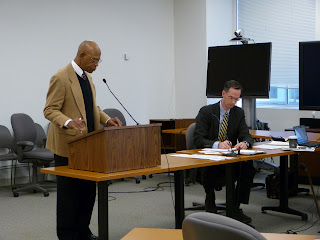AAEA - NY presented a statement on Tuesday before the New York Department of Environmental Conservation at a hearing at the New York Department of Public Service addressing the proposed Article 10 environmental justice regulations.
FULL STATEMENT
Excerpts
 |
| Dan Durett (ALJ Daniel O'Connell) |
In New York City, it is estimated that there are 2,290 deaths, 1,580 hospitalizations, 546 asthma-related emergency rooms visits, 1,490 cases of chronic bronchitis, and 46,200 asthma attacks yearly attributable to power plant pollution. The New York City Area has also been ranked as one of the top five U.S. metropolitan areas for particulate air pollution. And again, these adverse effects disproportionately affect minority communities. In one study, nonwhites in New York City were found to be hospitalized twice as many times as whites on days when ozone levels were high. Another study found that, of the 23 counties in New York State that fail to meet Federal air pollution standards, 37.7% of them are populated by people of color.
That African Americans and other minorities are disproportionately affected by air pollution in New York is not surprising when considering the fact that the majority of air polluting power plants in the New York metropolitan area are located in African American and other minority communities. Based on figures from the 2000 U.S. Census, only 12.3% of New York State is identified as being African American, and 29.4 % of the total population is classified as a minority. However, in communities that are predominantly minority, such as Queens, the Bronx, and Brooklyn, there are a disproportionate number of fossil-fuel power plants emitting criteria air pollutants. For example, there are approximately 1,563,400 people of color, 271,247 children living in poverty, and 40,248 children who suffer from pediatric asthma within 30 miles of a coal-fired power plant bordering the New York City metropolitan area. In the Bronx, which is 35.6% African American and 88% minority, there are two power plants. In Brooklyn, which is 36.4% African American and 64% minority, there are seven power plants. In Queens, which is 20% African American and 63.2% minority, there are six power plants. Queens is also ranked among the 10% of U.S. counties in terms of its exposure to criteria air pollutants, and is one of two city boroughs that violates federal standards. In total, there are 24 power plants in the New York Metropolitan area, only a handful of which are in areas where minorities do not comprise the majority of the population.
Finally, from a clean air environmental justice perspective, AAEA - NY is concerned
about the potential closure of Indian Point nuclear power plant. If this plant is closed, there will be
significant pressure to replace this emission free facility with fossil fuel power plants. This will only increase the burdens on
environmental justice areas if replacement power is located in these
areas.
No comments:
Post a Comment